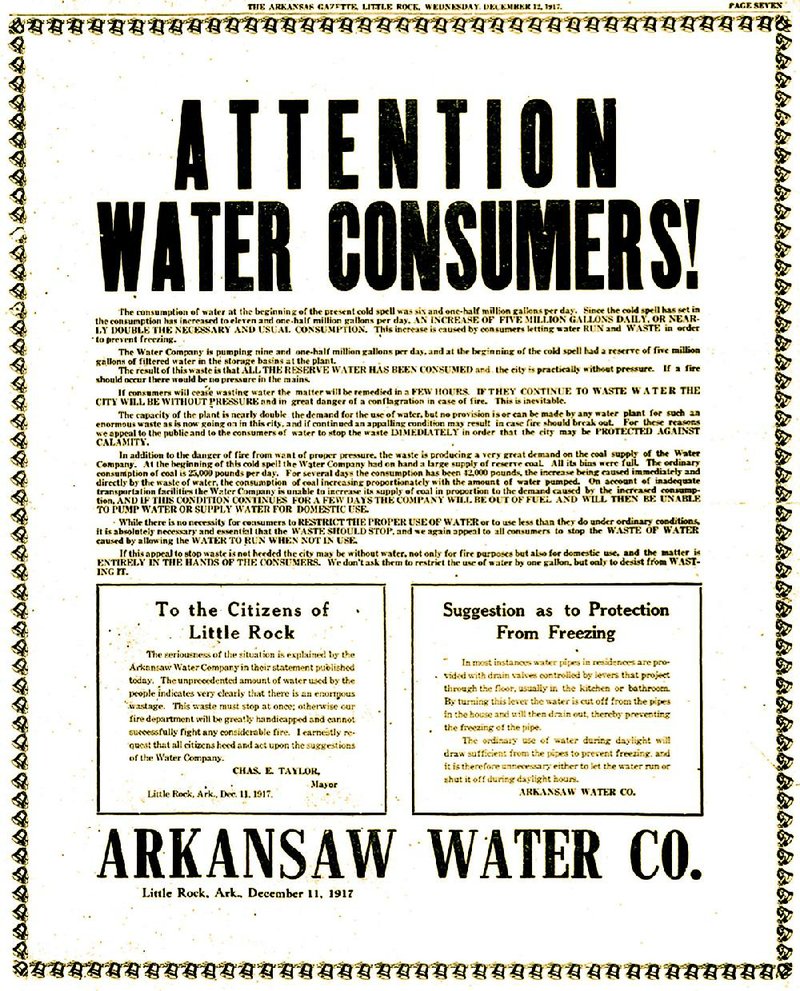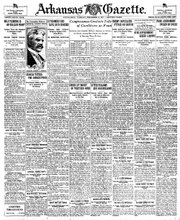December 1917 was so cold the Arkansas River froze at Little Rock.
A snowstorm that began Dec. 7 (as women were marking their first ballots in city primaries) led waves of frigid temperatures that made the Christmas season special -- in a bad way.
How cold was it? So cold that when 86-year-old Robert Scott collapsed into a snowdrift at Paragould, being buried in snow kept him alive.
So cold that $1,000 worth of poultry froze to death in transit to grocer Mose Smith & Co. at Harrison. So cold that calves fell in the field, and hunters found stiff rabbits and quail stretched upon the ground.
So cold that residents of Little Rock, fearing burst pipes, kept household taps running day and night until the water was gone. Let me type that again: gone. Little Rock ran out of water.
Dec. 9 dawned on a record 5 degrees above zero. The next day's Arkansas Democrat reported:
Low gas pressure and irregular street car service made Sunday one of the most disagreeable days ever experienced in Little Rock. Again at night the lights were shut off of Main street, and but for the snow it would have been difficult for pedestrians to get along. The inclement weather, however, kept most people off the streets.
Tapping out the water supply was no joke. Surgeons at St. Vincent Infirmary waited until night to perform operations, on the theory that pressure would rise at night. It didn't. There was no water in the 12 buildings of the State Hospital for Nervous Diseases (the mental hospital, which stood roughly between today's West Markham, Hooper and Palm streets). And Camp Pike was dry for a time, too.
A full-page notice from the Arkansaw Water Co. in city newspapers begged and threatened residents to stop wasting water. The Arkansas Gazette quoted water superintendent A.V. Bennett on Dec. 13:
The housewife who thinks the Arkansaw Water Company cannot tell when faucets are open within the house is mistaken, says Mr. Bennett. By a little device known as the water telephone, which is attached to the service line, the tiniest trickle of water from the faucet within a house can be heard. Following the order of Mayor Taylor the water company will cut off all users who permit the faucets to remain open to keep water from freezing in the pipes.
According to an item in a 1922 book, The Highlights of Arkansas History by Dallas T. Herndon, the waterworks' reservoirs were erected in 1886 on a bluff two miles upriver from the city center and 250 feet higher than the business district. (Sounds like today's Knoop Park to me; if that's incorrect I trust Helpful Reader to correct us.) Pumps pulled water from the river into the "bins," and the water passed through filters before it entered the mains.
The full-page notice stated that normal daily use of 6 1/2 million gallons had skyrocketed to 11 1/2 million gallons during the cold snap. The pumps were still running, but to maintain pressure, the plant had doubled its coal consumption.
Even in the years before the McClellan-Kerr Navigation System deepened its channel, the Arkansas River did not routinely ice over. The Democrat told its readers the last time was 1899, when ice was so thick skaters played on it and it was possible to slide stuff across to Argenta. The Gazette quoted the Little Rock Weather Bureau's list, which cited a few days each in 1881, 1886, 1887, 1892, 1895, 1899, 1901, and Feb. 4-10, 1905, as well as a partial freeze Feb. 15-19, 1905.
Demand for coal and natural gas to power and heat hastily erected Army barracks at North Little Rock's Camp Pike pushed supplies into the famine zone. There weren't enough railway cars to bring coal in from mines fast enough to meet demand. Schools and some businesses closed early. There was a run on candles and kerosene lamps ... but I see no mention in the press about milk and bread.
The Little Rock Railway and Electric Co. burned consumer-grade lump coal in furnaces that lacked blowers, and so it couldn't use other grades of coal to generate electricity. Without coal to power its plant, electric streetcars became unreliable. Lights were cut off downtown on a Saturday night, and as the Arkansas Gazette had it, you couldn't see whether your girl was out walking with another fellow.
There wasn't a light blinking anywhere on Main street. One enterprising Christmas shopper even came down town and examined the show windows with a pocket searchlight.
On the other hand, people kept their doors closed, because the wolf was out there.
Big Gray Wolf Killed a Half Mile From City
The wolves are right at our door, according to Edward Wurskey, who lives a half mile south of Biddle on Confederate avenue. Mr. Wurskey early Tuesday morning ended the career of a large gray wolf which had been raiding hen roosts in that vicinity for several days, after the wolf had made mince meat out of two valuable dogs belonging to Mr. Wurskey.
In our relatively wolfless modern world, we know that packs once prowled around common as coyotes, but as long ago as 1917, a wolf was already a wondrous monster.
Farmers in the vicinity reported that since Thanksgiving the wolf, which is nearly 5 feet long, had made off with 13 pigs, 7 ducks and several chickens. Mr. Wurskey's neighbors have bought a large number of steel traps in the hopes of exterminating the entire pack, if any more are wandering in the vicinity.
Wurskey nailed the carcass to a tree in his front yard.
Dec. 14, the Gazette's North Little Rock editor reported:
Some men left barber shops half shaved, unwilling to take the chance of being shaved by candle light. Another man was kept from paying a bill of several years' standing. He had gone into a store to pay up, but when the lights went out he refused to take a chance on taking change in the dark.
At Camp Pike, a rule forbidding the use of chains on auto tires was rescinded, but you can't put chains on hooves. A Gazette reporter saw three horses sprawled across the road during a single trip from Little Rock to Camp.
One mule "critter" who is usually found off his feet is old "Slacker," a large black mule who has been wished on to one of the supply wagon drivers. "Slacker" gained his name through his willingness to "lay down" at all convenient opportunities. He is said to watch his driver closely, and when a slippery place in the road is discovered, "Slacker" sits down, if he thinks he can get by with it. An officer yesterday said that he has seen "Slacker" lie down twice in the same place on two successive days, and the language of his driver as he sought to disentangle the trace chains apparently was sweet music to his ears.
By Dec. 18, the weather was warming; water pressure was restored, and the fuel crisis was seen as less hopeless.
Many things have changed since 1917 but other things have not. Even unto this day, mules know better than to work on ice.
Email:
ActiveStyle on 12/18/2017


